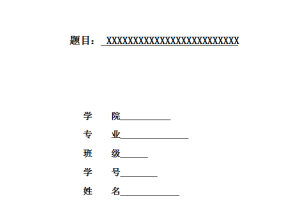内容提要
口头介绍,作为现代商务交际的一种重要方式,已经受到越来越多的商业人士的青睐。然而这种方式在其进行交流过程中经常会受到各种因素的影响,从而无法顺利达到商务交流的预期目的。因此本文将从交际理论入手,分析影响交际过程中的各个因素,从而寻找克服这些因素的突破口,进而总结出能有效加强商务交流的方法与技巧。
本文共分四章:
第一章实质为全文的导言,概括阐述了交际理论以及口头介绍在商务环境下的重要作用。
第二章论述了口头介绍准备过程中需考虑的几个因素,包括目的、文稿、听众、场合及影响环境的因素。
第三章着重介绍了排练过程中的一些技巧,强调反复训练对临场表现的重要性。
第四章主要阐述了临场做口头介绍时要注意的演讲技巧。同时,本章还分析了当今商务场合下的两种口头表述形式:一是传统意义下的以口述人为中心的表述形式,二是以技术为基础扩展开来的表述形式。
Abstract
Oral presentation, as a form of communication, plays a more and more important role in a modern business setting. According to one survey, businesspeople give an average of 26 presentations a year. But not all the presentations are effectively made for a variety of reasons. Therefore, this thesis aims to explore effective presentation skills and techniques. To better bolster this subject, the author, starting from the theory of communication, elucidates the skills in the following three phases of an oral presentation: preparation, practice and presentation.
The thesis falls into four chapters:
Chapter One, which in essence serves as an introduction to the whole thesis, unfolds the communication theory and the importance of oral presentations in business environment.
Chapter Two explores the factors that should be taken into consideration when presentations are prepared, including communication goals, speechwriting, audiences, blocks to speaking settings and presentation occasions.
Chapter Three mainly focuses on the skills when people practice their presentations, with emphasis on performance improvement by rehearsing.
Chapter Four deals mainly with some delivery skills on the presentation day. This chapter puts forth two styles of presentations: traditional speaker-centered presentations and technology-based presentations.
In concluding the thesis, the author highlights several points worthy of special attention in the three phases of a presentation, therefore achieving the goal of effective communication.
Acknowledgements
This thesis would not have turned out as it is, but for the generous help and expertise from a wide variety of sources.
Here I would like to take this opportunity to express my deepest gratitude to those who have contributed to the development of the ideas presented in this thesis in one way or another.
My thanks go first to Professor LUO Guoliang, my amiable tutor and mentor in research and daily life, whose enthusiastic support, intelligent suggestions and reference materials constantly guided my research and kept it from going astray. I am especially grateful to Professor Luo for his patient and rigorous inspection of the revision of this thesis and his unceasing help all through these two and a half academic years. All in all, the benefit I have gained from his instruction has been and will ever be part of my personal wealth for the rest of my life.
Much credit also goes to my lovely friends, Luo Xiuzhen, Gong Hui, Tang Lili and Zhao Baohe; from discussions with them I obtained many constructive suggestions and enlightening ideas.
To my family, I render my gratitude for constant encouragement and advice. Their enormous care and love enabled me to continue this paper with perseverance till its completion.





